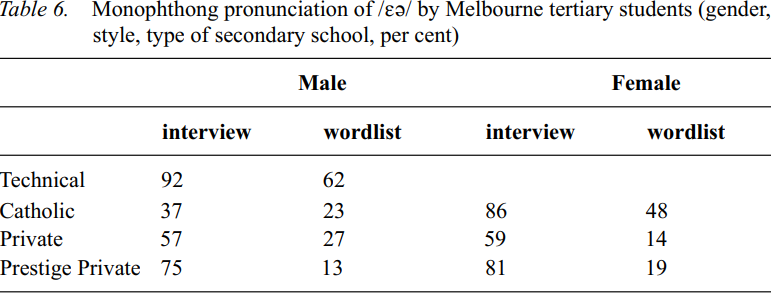
Offglides
 المؤلف:
David Bradley
المؤلف:
David Bradley
 المصدر:
A Handbook Of Varieties Of English Phonology
المصدر:
A Handbook Of Varieties Of English Phonology
 الجزء والصفحة:
650-36
الجزء والصفحة:
650-36
 2024-04-24
2024-04-24
 1111
1111
Offglides
There is considerable variation in the presence and prominence of offglides in the formerly mainly rhotic word classes NEAR, CURE, SQUARE, CLOTH. The main regional characteristic here is the very frequent presence of long monophthongal forms for NEAR and CURE vowels in Sydney. Monophthongs are very much less frequent elsewhere other than preconsonantally within a word as in years or toured. In addition, they are prevalent when prelateral in certain frequently-occurring polysyllabic words such as really. Monophthongs for NEAR in Melbourne range from three to 18 per cent of tokens overall, showing strong social and smaller gender and stylistic differences: working class speakers, males and casual style use more monophthongisation. Monophthongs represent 0 to 17 per cent of final and 10 to 35 per cent of preconsonantal NEAR tokens, again with a strong social difference, but also a substantial gender and style difference.
Monophthongal forms of SQUARE and CLOTH words are by contrast extremely frequent throughout Australia, with environmental constraints; a following consonant within the word favors a monophthong, parallel to NEAR and CURE. Conversely, strong stress and final position permit a virtually disyllabic realization, [ɪjз] for NEAR, [(j)ʊwз] for CURE, [εjз] for SQUARE, and [ɔwз] for CLOTH words without final consonant such as paw or pore (or for that matter poor; in Australian English many CURE words without a preceding /j/ glide have merged into the CLOTH class, and even those with the glide also vary between [jʊwз] and [jɔ] realizations). Table 6 (Bradley and Bradley 1979: 78) shows the pattern of monophthongisation for the NEAR vowel in Melbourne among tertiary-age students, favoring the offglide in isolation and also showing differences between speakers based on the type of secondary school attended, reflecting social differences. In the sample, there were no female students who had attended technical secondary schools.

 الاكثر قراءة في Phonology
الاكثر قراءة في Phonology
 اخر الاخبار
اخر الاخبار
اخبار العتبة العباسية المقدسة


